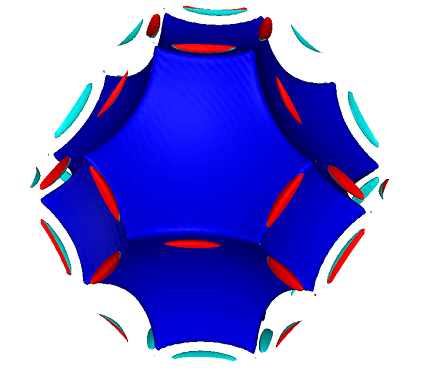
La grande maggioranza dei computer e supercomputer attuali sono basati su delle rappresentazioni classiche della memoria quali i bit, ovvero delle unità di calcolo che possono assumere valore uno o zero. Ogni numero può poi essere trascritto in questa rappresentazione binaria. I computer quantistici invece si basano su rappresentazioni della memoria che sono governate dalle leggi della meccanica quantistica. L’unità di base in questo caso è il qbit, ovvero una quantità che può esistere come sovrapposizioni di stati quantistici chiamati |0> e |1> e che può assumere entrambi i valori al tempo stesso.
Teoricamente, i computer quantistici potrebbero risolvere problemi non risolvibili dai computer classici (questa proprietà viene spesso chiamata ‘supremazia quantistica’). Purtroppo, la realizzazione pratica di computer quantistici stabili, con un grande numero di qbit, si è dimostrata essere un formidabile problema di fisica dei materiali, ancora irrisolto al giorno d’oggi.
La piattaforma su cui hanno scommesso molte delle più grandi ditte di computer del pianeta (Google, IBM, IMEC, BBN Technologies, Rigetti e Intel) è quella formata da circuiti quantistici basati su delle giunzioni di tipo Josephson che si ottengono introducendo barriere isolanti tra elettrodi di alluminio. L’alluminio è un superconduttore, ossia un materiale che se portato a circa -272 gradi Celsius sotto zero non oppone resistenza al passaggio di una corrente elettrica. È proprio questa sua proprietà che permette di generare dei qbit utilizzabili in circuiti quantistici.
Il problema principale di questa tecnologia è però dato dal fatto che i qbit che si ottengono sono estremamente fragili, e possono essere facilmente distrutti da fenomeni presenti in natura come i raggi cosmici. Ciò è legato alla bassa temperatura a cui l’alluminio diventa superconduttore. Si stima che l’impatto dei raggi cosmici riduca il tempo di coerenza del qbit sotto il decimo di microsecondo e che abbia un effetto distruttivo sul circuito quantistico in un raggio di circa 1 cm2. Questo problema è uno dei più limitanti per lo sviluppo di computer quantistici.
Il gruppo di ricerca che coordino al Dipartimento di Fisica dell’Università di Trento si occupa dell’ottimizzazione delle proprietà dei materiali, con un particolare focus verso lo studio delle proprietà dei superconduttori. In passato il gruppo si è distinto per aver concepito nuovi superconduttori basati sul grafene, un promettente materiale bidimensionale, e per aver spiegato la superconduttività nei superidruri. Inoltre il gruppo di ricerca ha sviluppato tecniche teoriche per ottimizzare le proprietà dei superconduttori. Per questo motivo Google ha deciso di attribuire al nostro lavoro il premio delle tecnologie quantistiche. Questo premio mira a instaurare una collaborazione tra il gruppo del Dipartimento di Fisica e Google al fine di migliorare la performance dei computer quantistici e soprattutto di aumentare la stabilità dei qbits, rendendoli resistenti al passaggio dei raggi cosmici attraverso un’ottimizzazione delle proprietà superconduttive delle giunzioni Josephson di alluminio.
Per arrivare a questo scopo, abbiamo utilizzato delle simulazioni numeriche dette ‘da principi primi’ che permettono di risolvere le complesse equazioni della meccanica quantistica con poche e controllate approssimazioni. In questo modo si possono descrivere le proprietà dei superconduttori con grande precisione e si può quindi determinare con quali materiali migliorare le giunzioni Josephson per costruire i computer quantistici del futuro.
È difficile dire se e quando un supercomputer quantistico stabile e con un grande numero di qbit sarà disponibile sul mercato. L’innovazione in fisica della materia e l’ottimizzazione dei superconduttori saranno probabilmente fattori cruciali per rimuovere molte delle difficoltà tecniche nello sviluppo delle tecnologie quantistiche. Il premio Google e la ricerca in fisica dei materiali al Dipartimento di Fisica lanciano l’Università di Trento in questa sfida globale.


Immagine 1: rappresentazione grafica degli stati quantistici occupati dagli elettroni nel alluminio metallico.
Immagine 2: rappresentazione grafica della struttura cristallina dell'alluminio.
Google, nell'ambito delle azioni di promozione della ricerca di eccellenza, ha assegnato all'Università di Trento un premio di 30.000 dollari da destinare agli studi di Matteo Calandra Buonaura e del suo gruppo di ricerca sull'ingegneria dei gap superconduttori.
Material science to develop more performing quantum computers
Matteo Calandra Buonaura and his research group received the Google award in the area of quantum technologies
by Matteo Calandra Buonaura
Full professor of the Physics Department of the University of Trento and director of research at the Paris Institute of Nanosciences of CNRS and Sorbonne University.
The great majority of today's computers and supercomputers are based on a classical representation of the memory based on bits, computational units that can have a value of either one or zero. Any number can be converted into this binary representation. Quantum computers, on the other hand, are based on representations of the memory that are governed by the laws of quantum mechanics. The basic unit in this case is the qubit, a quantity that can exist as superposition of quantum states called |0> and |1> and that can take on both values at the same time.
Theoretically, quantum computers could solve problems that cannot be solved by classical computers, an ability that is often called "quantum supremacy". But in practice, unfortunately, building stable quantum computers with many qubits is extremely difficult, a problem that material scientists haven't been able to solve yet.
Many of the largest computer companies on the planet (Google, IBM, IMEC, BBN Technologies, Rigetti and Intel) are exploring quantum circuits platforms based on Josephson junctions, which are formed by introducing insulating barriers between aluminum electrodes. Aluminum is a superconductor, that is a material that, if brought to about -272°C, opposes no resistance to the passage of electricity. It is precisely this property that makes it possible to generate qubits that can be used in quantum circuits.
The main problem with this technology, however, is that the resulting qubits are extremely fragile and can be easily destroyed by natural phenomena such as cosmic rays. This is because of the low temperature at which aluminum becomes a superconductor. The impact of cosmic rays is estimated to reduce the coherence time of qubits to less than a tenth of a microsecond and to have a destructive effect on the quantum circuit in a radius of about 1 cm2. This is one of the main obstacles to the development of quantum computers.
The research group that I coordinate at the Physics Department of the University of Trento is working to optimize the properties of materials, and is studying in particular the properties of superconductors. In the past, the group came to prominence for designing new superconductors based on graphene, a promising two-dimensional material, and for explaining the superconductivity of super hydrides. The research group has also developed theoretical techniques to optimize the properties of superconductors. That is why Google has decided to give us the award for quantum technologies. The purpose of this award is to establish a collaboration between the research group of the Physics Department and Google, to enhance the performance of quantum computers and, above all, increase the stability of qubits, making them resistant to cosmic rays by improving the superconducting properties of aluminum Josephson junctions.
To achieve this goal, we have used "first principles" numerical simulations thanks to which we can solve the complex equations of quantum mechanics with few and controlled approximations. In this way, the properties of superconductors can be described in great detail and it is therefore possible to determine which materials to use to improve the Josephson junctions to build the quantum computers of the future.
It is hard to say if and when a stable quantum supercomputer with a large number of qubits will be available on the market. Innovation in material science and the optimization of superconductors will probably be crucial to remove many of the technical difficulties in the development of quantum technologies. With the Google award and the research work of the Physics Department in material science, the University of Trento participates in this global challenge.
[Traduzione Paola Bonadiman]
Google, as part of the actions to promote excellence in research, awarded the University of Trento a 30,000 USD prize to Matteo Calandra Buonaura and his research group for their work on superconducting gap engineering.




